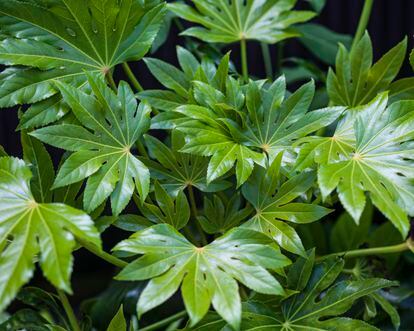Among gardeners' resolutions for January there is one that is usually more difficult to complete: bringing a large indoor plant into the house. When modesty is overcome, the transformation that operates in the environment is so beneficial that the initial reluctance is soon forgotten. The advantages begin with the visual change it produces in the room, since the space becomes green with a considerable sized plant, which works as a counterweight to the large furniture. If you already had other indoor plants in the same place, you will immediately see how it was necessary to complete the floristic procession with the new acquisition, which unifies all the plants and better structures the space by covering all the heights of the plants with it. that the room has.
When talking about a great indoor plant, those classic species of ficus first come to mind (Ficus spp.), although not alone. Of course, the gomero or rubber tree (Ficus elastica) is one of the candidates, due to its great resistance and beauty. Its large leaves ennoble any corner. Within this species there are very different cultivars: Ficus elastica 'Decora', 'Robusta', 'Abidjan' or the variegated 'Tineke'. The latter will require a greater amount of light, having that lack of chlorophyll in its leaf that makes it more in need of solar energy than its companions with entirely green leaves. This species of ficus is more resistant than the classic one Ficus benjaminawhich vegetates well with high lighting, but tends to lose leaves rapidly when it does not have the light it needs.
Among the resistant ficus there is an essential species: Ficus binnendijkii. Its leaves are very narrow and tend to be slightly pendulous, which gives it a different look. Two cultivars are the classics within this species: Ficus binnendijkii 'Alii' and 'Amstel King'. The latter has somewhat wider leaves than 'Alii'. But you can't talk about ficus without mentioning the classic Ficus lyrata, with its lyre-shaped leaves. Since it re-emerged as a fetish indoor plant for many people, it remains on its favorite pedestal.
DuKai photographer (Getty Images)
This large group of tree ficus should be joined by other plants with considerable size, such as the famous cheflera (Heptapleurum arboricola) —both in its green forms and in those with variegated leaves— and as the dracenas (Dracaena spp.). Within this last genus, the most recognizable species is Dracaena fragrans, which has given rise to many varieties with leaves in every imaginable range of green, yellowish and cream. Some of those classic varieties that everyone distinguishes are Dracaena fragrans 'Massangeana' or also the famous 'Lemon Lime'. With the dracenas one cannot forget the ones with narrow leaves, such as Dracaena reflexa var. angustifolia (Synonym of Dracaena marginata) or its cultivar 'Tricolor', with resistance beyond any doubt.

If we have a well-lit terrace without direct sun, we can try caring for an aralia (Fatsia japonica), which will bring its freshness and magnificent bearing to a corner. Its leaves can be enormous if it is well nourished, and thus becomes a substitute for the much cultivated Adam's rib (Monstera Delicious). The latter, although it is not a tree plant, could also be included in this select group of large species. In its place of origin it becomes as tall as the trees, when climbing their trunks and rocks and hills of the most tropical America.
All that remains is to choose one of these species and go to the nursery or florist to get it. With some of these large plants in the living room, the view will be festive every day and you will even feel that the environment will have another air, literally, because all these leaves will be there to provide newly produced oxygen, directly for our lungs.
Subscribe to continue reading
Read without limits
_
#tree #living #room #good #idea #large #plant #house